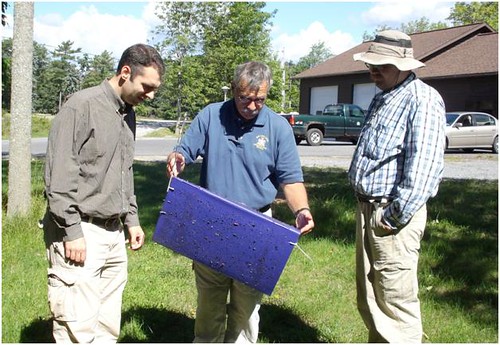
For centuries, the Mohawk community of the Akwesasne (pronounced AHG - weh - SAUCE – knee) have created traditional basketry from the abundance of ash trees found along the St. Lawrence Seaway and the Thousand Islands area in New York.
But for the last three years, the trees and the matchless creativity of the Akwesasne have been threatened by a particularly harmful insect called the Emerald Ash Borer.
Nicknamed “The Green Menace,” this beetle has been responsible for the decline of tens of millions of ash trees in the United States. Now comes word that EAB has been discovered less than 10 miles away in nearby Mallorytown, Ontario, heightening concerns even more.
The Thousand Islands region is a gateway between Canada, the Great Lakes region and the scenic Adirondacks. Campers and hikers routinely trek the region, transporting firewood—a practice which increases the likelihood of an infestation. Additionally, both sides of the border were home to major manufacturing and other industries, highlighting the potential risk of EAB introduction via solid wood packing material.
Les Benedict, an assistant director with the Saint Regis Mohawk Tribe’s environment division, understands how an EAB infestation would impact New York, having witnessed a similar event years earlier in Michigan. Today, Benedict fears that “20-plus years of effort to conserve and manage black ash may be for not,” as an EAB infestation would destroy “a legacy of basket making and the traditional knowledge that goes along with it.”
Enter USDA’s Animal and Plant Health Inspection Service (APHIS) to lend a helping hand. For the past three years, Thomas Colarusso, an APHIS plant health safeguarding specialist, and New York State Department of Agriculture and Markets (NYS DAM) horticultural inspector Eric Birkland have monitored Kring Point State Park in the Thousand Islands region for the EAB’s presence. About 80 miles away, the tribe did its own monitoring with the help of APHIS.
With the park supervisor’s cooperation, the team chose three high-risk trees early in the spring and “girdled” them to induce stress.
Colarusso explained that an 8- to 10-inch vertical section of bark was removed from around the tree’s midsection. This causes a tree to become starved, or stressed, and to emit a scent or chemical that could draw opportunistic insects. “We hung purple sticky traps in the trees with standard EAB lures and monitored throughout the season for suspects. No suspects were found and the traps have all been removed,” Colarusso said.
Benedict predicted that efforts to prepare for and respond to any EAB invasion “will eventually prevail.”
“It is good knowing we have a partnership with USDA-APHIS to provide the technical assistance and support that will improve our ability to protect our ash resources and, therefore, our basket-making legacy.”
For more information about invasive pests like the emerald ash borer, visit www.hungrypests.com.


